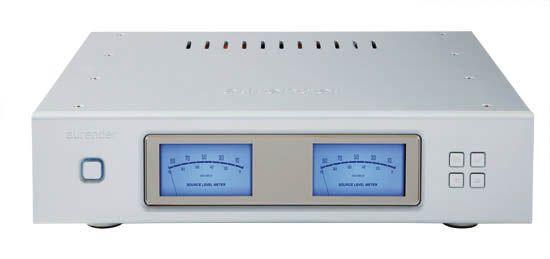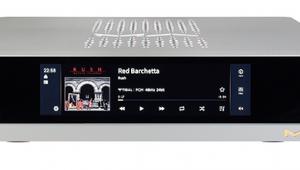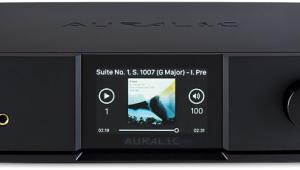Aurender S10 (£4995)

Aurender music servers are new to the UK. Made by WideaLab, a specialist subdivision of Korea’s Wonik Corporation, they are designed for pure audio replay of a lossless digital music library – aimed squarely at audiophiles who care passionately about sound quality. That’ll be us, then!
For music lovers who simply can’t be doing with the complexities of computer audio there are server systems such as those from Olive, Sooloos, and Naim that are designed to be straightforward plug-and-play options. You hook them up to an audio system as you would a CD player. Load a CD into the built-in drive and it is ripped automatically to the HDD. So what precisely is an Aurender server? And what makes it an ‘audiophile server’?
Well, if you’ve ever observed that something as trivial as a 75ohm coaxial cable connecting a CD transport to a DAC can affect sound quality, or that supporting audio components on vibration-isolating equipment racks can alter perceived sound, you’ve already bought in to the notion that everything can make a difference in a high-end audio system.
Consequently, that a digital file might survive the hostile environment of a home computer and emerge unsullied as a bit-perfect rendition of the CD from which it was ripped seems largely unfeasible. This is Aurender’s raison d’être: that the computer serving the music files should be as simple and ‘purist’ as possible – and that, in the best audiophile tradition, nothing should be taken for granted.
STRONG BUT SILENT
So it’s built like a high-end audio component. Its substantial chassis comprises aluminium top and bottom plates with finned heatsinks at the sides and two active matrix OLED displays on the heavyweight fascia. Inside it’s a customised, minimalist Linux computer that provides the bare bones functionality of an audiophile-quality music server. The chassis compartmentalises the Aurender’s hard drives from its switch-mode and linear power supplies, its motherboard, and the (digital) audio board with its oven-controlled crystal oscillator (OCXO) clock.
Designed to reside in an equipment rack alongside other source components, it is silent in operation as no internal cooling fans are required. While further models are on the horizon from Aurender, this S10 version features a 2TB HDD together with a 64GB solid-state drive (SSD). During playback, selected songs are cached automatically to the SSD. The HDD then ‘falls asleep’. And the real beauty is that the Aurender is simply a ‘transport’, with digital outputs for connecting to an audio enthusiast’s DAC of choice. It supports 16-bit/44.1kHz through to 24-bit/192kHz high resolution audio through S/PDIF (coaxial and optical) and AES/EBU (XLR) outputs. USB output is not currently provided, however. All lossless file formats relevant to audiophile playback are supported, such as AIFF, WAVE, FLAC, Monkey’s Audio APE and Apple Lossless.
YOU NEED AN IPAD
As well as being designed to provide an as-near-perfect digital source as possible, a server such as this should be ideal for audiophiles who want a straightforward ‘set and forget’ computer audio solution – and who certainly wouldn’t contemplate building their own server system.
But first you have to get your CDs (and hi-res downloads) onto the Aurender’s internal HDD. This is supposed to be easy, but managing the contents of your library does require the use of a computer attached to your network [see boxout].
Moreover there’s something rather important that I haven’t yet told you: to drive the Aurender properly requires that you own an iPad. Yes, you read that correctly. Add the cost of purchasing an iPad to the price of ownership. There are basic control buttons on the S10’s fascia for play/pause and scrolling back and forth between tracks in a playlist – and the easy-to-read display indicates artist name and track title in addition to key information regarding time elapsed/remaining, file type and bit-depth/sampling frequency of the track being played – but key to the operation of the Aurender is the company’s ‘Conductor’ application designed solely for the iPad. It’s free of charge from Apple’s App Store. Sadly, the iPad isn’t!
The S10’s ethernet port needs to be connected to a wireless router in order to retrieve album data from the internet, download firmware updates, and communicate wirelessly with your iPad. Aurender’s attractively designed application is arguably the next best thing to the graphical user interface of a Sooloos system, browsing one’s library by artist, album, track or genre all proving fairly intuitive once the system is up and running. Options such as ‘Play Now’ or ‘Add To Playlist’ pop up when holding a finger on a track selection. It responds quickly to commands, too. It did freeze up occasionally, but simply by quitting the App and re-starting it recovered operation in a matter of seconds.
LIKE FOR LIKE
I began by selecting a few 16/44.1 tracks from my digital ‘library’ and burned them to a CD-R. The same files were installed on the Aurender S10. The CD-R was played on a Pioneer PD-S06 Stable Platter Mechanism CD player used simply as a transport, connected to Chord Electronics’ fabulous QBD76HD D-to-A converter via S/PDIF using a 1m Atlas Ascent 75ohm coaxial cable (£100). When playing out the WAVs from the Aurender I used the same digital interconnect into the identical input of the Chord DAC. Would I really hear a difference in sound quality? And what about Chord’s on-board RAM buffer that sequentially takes and re-times all the data? This would surely level the playing field.
Amazingly – even with the Chord DAC’s RAM buffer set to ‘Max’ – there were clear differences in perceived sound quality. I would never have complained about the sound from the CD-R. After all, I was hearing the vivid, crystal-clear sound of the Chord DAC… Patricia Barber’s ‘Bye Bye Blackbird’ from Nightclub [Blue Note/Premonition 7243 27290 2 9] was simply delicious as the drummer’s brushes delicately stroked the snare drum, and the bass and piano sounded full-bodied and reverberant within the soundstage. Yet when fed from the Aurender the sound gained increased focus and dynamic realism. The image deepened, too. It sounded absolutely stellar.
FEAST OF DELIGHTS
Similar improvements could be heard when listening to the up-tempo fusion of ‘The Ghost of Mayfield Lodge’ by Brand X from Masques [Charisma VJCP-68785]. Again, you would be impressed by the openness of this jazz-rock track from the late ’70s, the individual contributions from Percy Jones on bass guitar, Chuck Bürgi on drums and John Goodsall on guitar remaining distinctly clear despite the recording coming from an era where excessive multi-tracking was beginning to wreak havoc on audio fidelity. Served up (no pun intended) from the Aurender S10, however, the increased focus and clarity was nothing short of startling. Leading edges appeared more sharply defined than when played from CD, the instruments beautifully separated in their different sections. The detailing of Morris Pert’s percussive elements really sparkled and sounded tremendously lifelike – as if the piece had been recorded in high resolution only last week.
It was as if the Chord DAC was now being allowed to reach its full potential, lending stark realism to the sound of instruments and voices. Adele’s middle-of-the-road ballad ‘Make You Feel My Love’, from 19 [XL Recordings XLCD 313], might highlight the singer’s ‘Queen of Boring’ mantle, but it’s a reasonably good recording for a modern pop album. Prior to the introduction of the string accompaniment later in the song, the solo piano and voice sound fresh and immediate in the image, if a little cold and stark. Via the Aurender the piano sounded bolder and wider in tonal range, while Adele’s voice positively leapt out into the listening room!
If I was startled by the clarity and dynamics of the Aurender when listening to 16-bit/44.1kHz rips of compact discs, I was in for a feast of delights when playing back hi-res material that I’d loaded onto the S10 from my laptop via my home network. I was spellbound by the ‘Hopak’ from Tchaikovsky’s Mazeppa played by the Minnesota Orchestra under Eiji Oue [24/176.4 recording from Reference Recordings HR-71]. I don’t believe my system has ever sounded this good.
VERDICT
The first-class sound quality of the S10 is proof positive of the design concept. Attention to fine details has paid dividends. But I’d like to see Aurender’s iPad application further developed to allow file management. As it is, you’ll need to be a really proficient computer user to live with an Aurender. Moreover, desirable though it may be, an iPad is an expensive remote controller. Apps for other platforms would be welcome…
Originally published in the December 2011 issue




























































